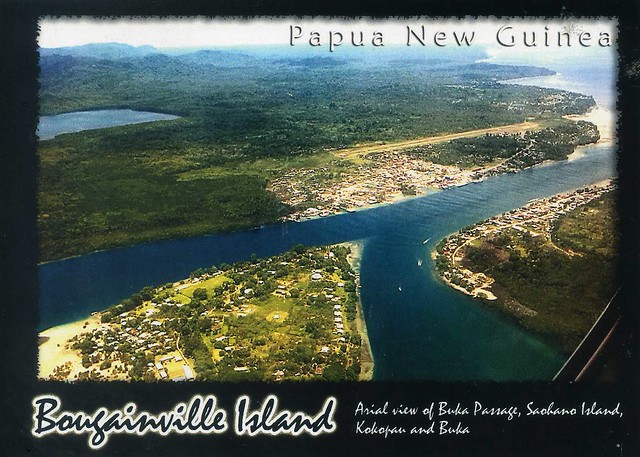A new country to my collection! 2015 has been pretty good postcard-wise so far :)
Bougainville Island is the main island of the Autonomous Region of Bougainville of Papua New Guinea. This region is also known as Bougainville Province or the North Solomons. Its land area is 9,300 km2. The population of the province is 175,160 (2000 census), which includes the adjacent island of Buka and assorted outlying islands including the Carterets. Mount Balbi at 2,700m is the highest point. Although Bougainville Island is geographically part of the Solomon Islands archipelago, the state of Solomon Islands is not a part of Papua New Guinea.
Papua New Guinea is an Oceanian country that occupies the eastern half of the island of New Guinea and its offshore islands in Melanesia, a region of the southwestern Pacific Ocean north of Australia. Its capital, located along its southeastern coast, is Port Moresby. The western half of New Guinea forms the Indonesian provinces of Papua and West Papua.
Papua New Guinea is one of the most culturally diverse countries in the world. 848 languages are listed for the country, of which 12 have no known living speakers. Most of the population of over 7 million people live in customary communities, which are as diverse as the languages. It is also one of the most rural, as only 18 per cent of its people live in urban centres. The country is one of the world's least explored, culturally and geographically, and many undiscovered species of plants and animals are thought to exist in the interior.
Strong growth in Papua New Guinea's mining and resource sector has led to the country's becoming the sixth fastest-growing economy in the world as of 2011. Many people in the country live in extreme poverty when measured in terms of money, with about one-third of the population living on less than US$1.25 per day.
At the local level, the majority of the population still live in strong customary societies and - while social life is overlaid with traditional religious cosmologies and modern practices, including conventional primary education - customary subsistence-based agriculture remains fundamental. These societies and clans are explicitly acknowledged within the nation's constitutional framework. The Papua New Guinea Constitution expresses the wish for "traditional villages and communities to remain as viable units of Papua New Guinean society" and for active steps to be taken in their continuing importance to local and national community life.
At the national level, after being ruled by three external powers since 1884, Papua New Guinea established its sovereignty in 1975 following 70 years of Australian administration. It became a separate Commonwealth realm with Queen Elizabeth II as its head of state and became a member of the Commonwealth of Nations in its own right.
Subscribe to:
Post Comments (Atom)




 Maroon
Maroon 










































































































































































No comments:
Post a Comment